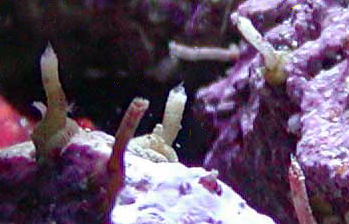Lifespan: In optimal conditions, Bumblebee Snails can live for approximately 1 to 2 years. However, factors such as water quality, diet, and tank mates can influence their lifespan.
Diet and Cleaning Role: Bumblebee Snails are primarily scavengers and feed on detritus, uneaten food, algae, and decaying organic matter within the aquarium. Their voracious appetite for organic debris makes them a valueable addition to an aquarium clean-up crew. Thes snails will help to prevent the accumulation of waste that can degrade water quality and fuel algae growth. Additionally, these snails are known to consume small pest organisms such as vermetid snails, which can proliferate rapidly and pose a nuisance in aquariums.
Benefits in Aquarium Maintenance: Keeping Bumblebee Snails in an aquarium can significantly reduce the need for manual cleaning and maintenance. By continuously foraging for food and consuming organic waste, they contribute to the overall cleanliness and health of the aquarium environment. Their presence can also help to mitigate algae outbreaks, keeping the tank visually appealing and conducive to the well-being of other inhabitants.
Predators and Tank Compatibility: While Bumblebee Snails are relatively small and inconspicuous, they may fall prey to certain aquarium inhabitants, particularly predatory fish and larger invertebrates. Therefore, it's essential to consider the tank's inhabitants carefully and ensure compatibility to prevent predation on these beneficial snails.
Reproduction in Captivity: Bumblebee Snails are known to reproduce readily in captivity under favorable conditions. They are dioecious (dai·ee·shuhs), meaning individuals are either male or female, and sexual reproduction occurs through the fertilization of eggs laid by females. Adequate food supply and stable water parameters are key factors that can encourage breeding behavior in these snails.

Effective Population for Vermetid Snail Control: Vermetid snails, with their calcareous tubes are known to be an overall nusance in an aquarium. Left unchecked, these sessile snails can overpopulate an aquarium and can pose a challenge by outcompeting desirable corals and encrusting organisms for space. Bumblebee Snails are known to prey on vermetid snails, offering a natural solution to control their population. The number of Bumblebee Snails required for effective vermetid snail control depends on the size of the aquarium and the severity of the infestation. As a general guideline, a higher population density of Bumblebee Snails may be necessary in larger aquariums or in cases of extensive vermetid snail colonization. Some recommend 5 -10 Bumblebee Snails per 20 gallons of tank water but it really depends on how out of control your vermetid population has become.
If you are looking for a good overall snail for your clean-up crew and something that can target a pest like the Vermetid Snail then we hope you will consider keeping the Bumblebee Snail (Engina mendicaria) in your reef aquarium as part of your aquarium clean up crew.





